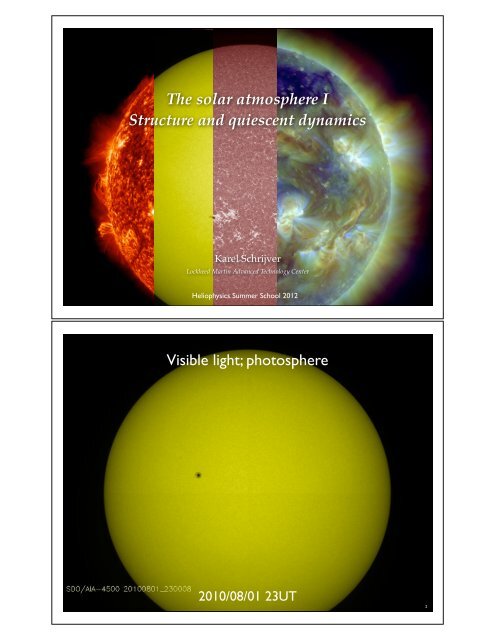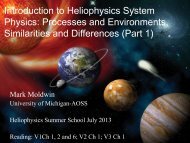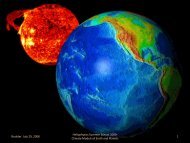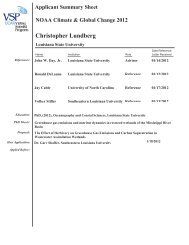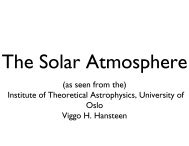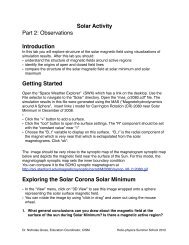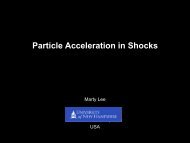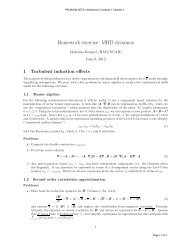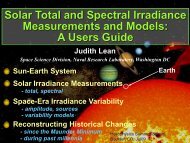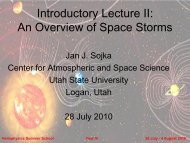The solar atmosphere I Structure and quiescent dynamics Visible ...
The solar atmosphere I Structure and quiescent dynamics Visible ...
The solar atmosphere I Structure and quiescent dynamics Visible ...
- No tags were found...
Create successful ePaper yourself
Turn your PDF publications into a flip-book with our unique Google optimized e-Paper software.
<strong>The</strong> <strong>solar</strong> <strong>atmosphere</strong> I<strong>Structure</strong> <strong>and</strong> <strong>quiescent</strong> <strong>dynamics</strong>Karel SchrijverLockheed Martin Advanced Technology CenterHeliophysics Summer School 2012Karel Schrijver Heliophysics Summer School 2012<strong>Visible</strong> light; photosphere2010/08/01 23UTKarel Schrijver Heliophysics Summer School 20122
UV ~1600Å; high photosphere, low chromosphere2010/08/01 23UTKarel Schrijver Heliophysics Summer School 20123He II 304Å; chromosphere2010/08/01 23UTKarel Schrijver Heliophysics Summer School 20124
EUV 131Å; corona2010/08/01 23UTKarel Schrijver Heliophysics Summer School 20125EUV 171Å; corona2010/08/01 23UTKarel Schrijver Heliophysics Summer School 20126
EUV 193Å; corona2010/08/01 23UTKarel Schrijver Heliophysics Summer School 20127EUV 211Å; coronaCoronal hole: field reaches farinto the heliosphere, stretchedout by the <strong>solar</strong> wind; holes atlow-to-mid latitude persist formonths, over the poles formuch of the cycleN.B. X-ray/EUV bright“points”: over smallemerged bipoles <strong>and</strong>over chance encountersof opposite polaritiesEphemeral region:never had spot orpore in its evolutionActive region: had at leastone sunspot at some pointin its evolution2010/08/01 23UTKarel Schrijver Heliophysics Summer School 2012Quiet Sun = not anactive region, ...8
EUV 335Å; corona2010/08/01 23UTKarel Schrijver Heliophysics Summer School 20129EUV 94Å; corona2010/08/01 23UTKarel Schrijver Heliophysics Summer School 201210
B + EUV 171Å2010/08/01 23UTKarel Schrijver Heliophysics Summer School 201211Line of sight magnetic field2010/08/01 23UTKarel Schrijver Heliophysics Summer School 2012 12
Line of sight B with “PFSS field lines”http://sdowww.lmsal.com/suntoday/2010/08/01 23UTKarel Schrijver Heliophysics Summer School 201213Basic structure of the nearest star• Radiative core - 0 to 0.71 of the radius (Rs)Inside 0.2 Rs hydrogen burns to heliumEnergy is transported by radiation• Contains 98 % of the <strong>solar</strong> mass• Convective zone - 0.71Rs to the <strong>solar</strong> surface• Energy is transported largely by mass motion• Contains 2% of the <strong>solar</strong> mass <strong>and</strong> 64% of the <strong>solar</strong> volume• Virtually all energy leaves the Sun from the surface - PhotosphereKarel Schrijver Heliophysics Summer School 201214
“Sun-like” stars - from the perspective of activity?Solar structureAll rotating stars with convectiveenvelopes exhibit atmosphericmagnetic activity.Karel Schrijver Heliophysics Summer School 201215Stellar evolution <strong>and</strong> luminosity/radianceHertzsprung-Russell diagramluminosity-age diagramRadii in <strong>solar</strong>unitsLuminosityLuminosityKarel Schrijver Heliophysics Summer School 201216
Domains in the <strong>solar</strong> <strong>atmosphere</strong>Domain: “Definition” “Conceptually”• Photosphere• Chromosphere• Transition Region• Corona• Heliosphere• Optically thick to thin• Optically thick in strong lines only• ?• Optically thin X-ray to IR• ?• Scattering-free l.o.s. in continuum• 10-20 kKelvin• Transition in ionization <strong>and</strong> plasma β• > 1MK• Beyond “Alfvén” pointN.B. From photosphere to geospace: 5 g/cm 2Earth <strong>atmosphere</strong>: 1,000 g/cm 217Domains in the <strong>solar</strong> <strong>atmosphere</strong>Domain: Energy balance Plasma/field• Photosphere b• Chromosphere• Transition Region• Corona a• Heliosphere• Hot upflows, radiative cooling• Non-radiative EM heating, someacoustic heating; radiative cooling• Conductive heating from above;radiative cooling• Non-radiative EM heating, cooled byconduction <strong>and</strong> radiation• Outflow of plasma, cooling byexpansion, heated by waves• High plasma β except in strong field;frozen in field; single-fluid MHD• Plasma β wide range around butmostly above unity; multi-fluid MHD• Low plasma β; MHD approximation• Low plasma β; MHD approximation• Plasma β ranges around unitya: <strong>The</strong> closed-field domain is often in near-hydrostatic balance.N.B. <strong>The</strong> open-field corona is cooled mostly by conduction <strong>and</strong> expansionb: Mostly in near-hydrostatic stratification, except in strong downflows which can be supersonic.18
ComparisonofpropertiesFrom Vol. IOur intuition (based onwhere we can live [greenbox] is of little use thinkingabout the <strong>solar</strong> <strong>atmosphere</strong>[yellow, blue, red boxes]19ARPlasma βQS• Rough estimate for medium-sized active region(Gary, 2001SoPh..203...71G)20• Characteristic quiet-Sun region(Schrijver <strong>and</strong> Van Ballegooijen,2005ApJ...630..552S)
Magnetoconvective structures21Magnetic ‘elements’22
<strong>The</strong> dynamic magnetic fieldEarth to scale23<strong>The</strong> dynamic magnetic fieldEarth to scale24
<strong>The</strong> dynamic magnetic carpetKarel Schrijver Heliophysics Summer School 201225<strong>The</strong> dynamic magnetic carpet10 MmKarel Schrijver Heliophysics Summer School 201226
Spectrum of emerging bipolar regions• Bipolar regions form acontinuum from large activeregions to small ephemeralregions, <strong>and</strong> perhaps evensmaller “intranetwork field”:• Regions with less flux• Increased spread in latitude<strong>and</strong> orientation;• Less cycle dependence,perhaps slightanticorrelationWas an obs.limit: TBDwith HinodeWas a FOVproblem: TBD withSDOEphemeral regionsCycle 22min. to max.Active regionsKarel 4Schrijver Heliophysics Summer School 2012 06/10/10<strong>The</strong> dynamic magnetic field“Carrington map”Obs. magnetogram28
Data taken at Swedish Solar Telescope, La Palma, SpainCourtesy Luc Rouppe van der Voort (University of Oslo)
FWHM 66 mÅHα -1.3Å (-60 km/s)Hα line core
<strong>The</strong> dynamic <strong>atmosphere</strong>http://aia.lmsal.com/public/results.htm#imagesaia.lmsal.com33Sunspot cycleKarel 6Schrijver Heliophysics Summer School 2012 06/10/10
Simulations of activitySimulated “Sun” from40°N, “co-rotating”:Karel 10Schrijver Heliophysics Summer School 2012 06/10/10Small-scale field essentially constant<strong>The</strong> 2008-2009 sunspot minimum hashistorical precedents, but is unrivaled inthe era of modern instrumentation.2009/03/01Ever-present mixed polarity(event during Maunder Minimum?)Karel Schrijver Heliophysics Summer School 201236
All magnetic elements contribute tototal <strong>solar</strong> irradiance (TSI)Karel Schrijver Heliophysics Summer School 2012Feulner: http://adsabs.harvard.edu/abs/2011GeoRL..3816706F37Magnetic energy conversion in stellar <strong>atmosphere</strong>s• Magnetized chromosphere <strong>and</strong> corona form anintegrated system (E chr./TR ≈30E cor./hel. ; M chr./TR ≈50M cor./hel. )Magnetic activity• power-laws; over 100,000x in flux density atRöntgen wavelengths.• Basal “background” heating:• adequate wave power, acoustic tunneling, magneticcarpet, magneto-acoustic couplings, …?Coronal activitySunAE Phe! EriWolf 359 M6.5Sun!Tau K5 IIIChromospheric activityKarel Schrijver Heliophysics Summer School 201238
“Flux-flux relationships”• At moderate spatial <strong>and</strong> temporal resolution, radiative losses from anythermal domain in a cool-star <strong>atmosphere</strong> scale with the (unsigned)magnetic flux density underneath:• F i= a b• Coronal flux density depends nearly linearly on magnetic field,chromospheric flux density close to a square root.Karel Schrijver Heliophysics Summer School 201239Rotation <strong>and</strong> age: evolution <strong>and</strong> mass lossKarel 22Schrijver Heliophysics Summer School 201240
Evolution <strong>and</strong> angular momentumMoment of inertiaLuminosityKarel 20Schrijver Heliophysics Summer School 201241<strong>The</strong> Sun in time42
Evolving Sun & EarthVolume IIIVolume IIIVolume III43Karel 44SchrijverHeliophysics Summer School 2012 06/10/10
<strong>The</strong> <strong>solar</strong> <strong>atmosphere</strong> IIExplosions <strong>and</strong> eruptionsKarel SchrijverLockheed Martin Advanced Technology CenterHeliophysics Summer School 2012Karel Schrijver Heliophysics Summer School 2012Magnetic “free” energy in coronal field• Significantly non-potential : ~10-30% of the regions on the surface.• ARs with significantly * non-potential coronae are ~3x more likely to produces CMXflares that on average are ~3x more energetic.* based on a subjective comparison of images <strong>and</strong> field extrapolations.15Karel Schrijver Heliophysics Summer School 201206/10/10
Mapping “free” energyPre-flarePost-flareNonlinear force-free field model: Schrijver et al., ApJ 675, 1637 (2008)47Explosions <strong>and</strong> eruptions48
Magnetic instability49Dynamics of eruption50
Appearance of flares• “Neupert effect”: soft X-rays behave as“capacitor” for hard X-rays• Goes X-rays: ~!"1% of flare radiativeenergy• (X)(E)UV: ~30% of flare radiative energy• <strong>Visible</strong> light: bulk of radiative energy, butagainst bright photosphere• Rough equipartition between “radiant”<strong>and</strong> bulk kinetic energy, with substantialspread.51Power law for flare class• Cause of power-law behavior: “self-similarity”,“self-organized criticality”, intrinsic coronal orintrinsic to dynamo?52
Energy & SEP fluencesSchrijver et al. (2012), JGR (Space Physics)1,000 Hiroshima bombs10 11 Hiroshima bombs53Coupled disturbances• Left: intensities Red/Green/Blue: ~2, 1.5, 1 million degrees• Right: “running ratios”, showing relative intensity changes54
Coupled eventsSDO/AIA 304A55Coupled eventsSDO/AIA 304A56
Coupled eventsSDO/AIA 211/193/171A - ~2/1.5/1MK572010/08/01Coupled events58
Experimenting with the “potential-field source-surface” modelmixing past <strong>and</strong> future informationFront hemisphereLine of sight fieldobservations• ßFrompast tofuture592010/08/01Coupled events60
2010/08/01Coupled events613D Simulation of Coupled Destabilizations of Flux RopesTörök et al. (2011)62
2010/08/01: Sun to heliosphere• “Long-range magnetic couplings between <strong>solar</strong> flares <strong>and</strong> coronal mass ejections observed by SDO <strong>and</strong>STEREO”, Schrijver,#C.#J.; Title,#A.#M., Journal of Geophysical Research, Volume 116, Issue A4, CiteID A04108(2011), 10.1029/2010JA016224, http://adsabs.harvard.edu/abs/2011JGRA..11604108S• “A Model for Magnetically Coupled Sympathetic Eruptions”, T. Toeroek et al., <strong>The</strong> Astrophysical Journal Letters,Volume 739, Issue 2, article id. L63 (2011), 10.1088/2041-8205/739/2/L63, http://adsabs.harvard.edu/abs/2011ApJ...739L..63T• “Three-dimensional Reconstruction of an Erupting Filament with Solar Dynamics Observatory <strong>and</strong> STEREOObservations”, T. Li et al., <strong>The</strong> Astrophysical Journal, Volume 739, Issue 1, article id. 43 (2011),10.1088/0004-637X/739/1/43, http://adsabs.harvard.edu/abs/2011ApJ...739...43L• “An Analysis of the Origin <strong>and</strong> Propagation of the Multiple Coronal Mass Ejections of 2010 August 1”, R.A.Harrison et al., <strong>The</strong> Astrophysical Journal, Volume 750, Issue 1, article id. 45 (2012), 10.1088/0004-637X/750/1/45, http://adsabs.harvard.edu/abs/2012ApJ...750...45H• “Characteristics of Kinematics of a Coronal Mass Ejection during the 2010 August 1 CME-CME InteractionEvent”, M. Temmer et al., <strong>The</strong> Astrophysical Journal, Volume 749, Issue 1, article id. 57 (2012), 10.1088/0004-637X/749/1/57, http://adsabs.harvard.edu/abs/2012ApJ...749...57T• “Interactions between Coronal Mass Ejections Viewed in Coordinated Imaging <strong>and</strong> in situ Observations”, Y.D. Liuet al., <strong>The</strong> Astrophysical Journal Letters, Volume 746, Issue 2, article id. L15 (2012), 10.1088/2041-8205/746/2/L15, http://adsabs.harvard.edu/abs/2012ApJ...746L..15L• “<strong>The</strong> 2010 August 1 Type II Burst: A CME-CME Interaction <strong>and</strong> its Radio <strong>and</strong> White-light Manifestations”, J.C.Martinez Oliveros et al., <strong>The</strong> Astrophysical Journal, Volume 748, Issue 1, article id. 66 (2012), 10.1088/0004-637X/748/1/66, http://adsabs.harvard.edu/abs/2012ApJ...748...66M• “Global three-dimensional simulation of the interplanetary evolution of the observed geoeffective coronal massejection during the epoch 1-4 August 2010”, C.-C. Wu et al., Journal of Geophysical Research, Volume 116, IssueA12, CiteID A12103, 10.1029/2011JA016947, http://adsabs.harvard.edu/abs/2011JGRA..11612103W• “Multi-point shock <strong>and</strong> flux rope analysis of multiple interplanetary coronal mass ejections around 2010 August1 in the inner heliosphere”, C. Möstl et al., subm. to the Astrophysical Journal.• [In preparation], D. Odstrcil et al. on hydrodynamic modeling of CMEs.63Karel 44SchrijverHeliophysics Summer School 2012 06/10/10


